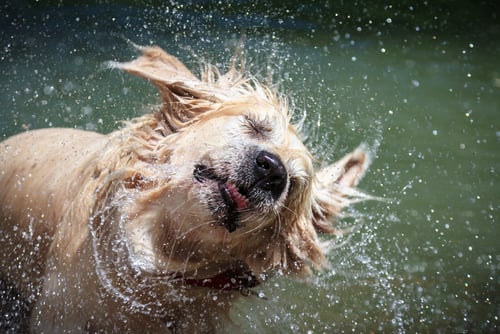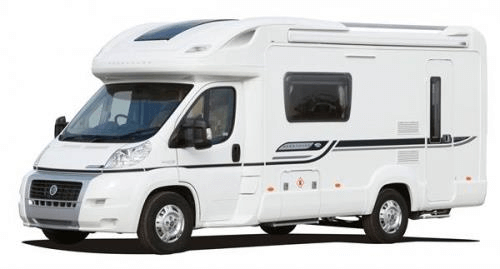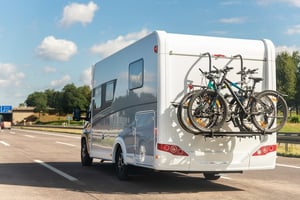Are you heading to Europe in your motorhome and thinking of bringing your car along for the ride?
If you are anything like us, you might be in the process of planning your summer trips and weekends away this year, and therefore considering whether to put your dog into kennels or to let them tag along. We love taking our dogs away with us for the weekend or longer - they are part of the family and we wouldn’t have it any other way. There’s nothing nicer as a dog owner than having your dog travel with you, enjoying the holidays with the rest of the family. However, there are some things to be aware of when travelling in your motorhome with your four-legged friend, and it’s not just offending other people or having to constantly work out where the next dog litter bin might be. Read on to find out our top tips for protecting both your dog, your motorhome… and your sanity.
What’s that smell?
Bless their little hearts. Our pooches are the harborers of many an interesting smell, which might be ok out in the open but they can really pack a punch in an enclosed space like a motorhome.
I bet if I were to say ‘wet dog smell’ you could conjure that olfactory sense up in an instant. It’s not the most unpleasant of smells, but it is quite specific. To that end, try not to let your dog into the motorhome when wet, if you can. Even if you aren’t planning on the weather taking a turn for the worse, there are always puddles, lakes, ponds and the sea to contend with. Take plenty of towels that you can use in rotation - microfibre ones are good at clinging to dirt and liquid, so investing in a pile of these is probably a good idea. This is also where an awning comes in handy - they are great at being the designated doggy drying area.
This obviously goes without saying, but do try to ensure that your dog is not sick or has other accidents in the motorhome as much as possible. It’s a good idea to check they are not travel sick before setting off on a long journey (you can get travel sickness tablets for dogs, and also do avoid feeding them straight before setting off - give it a few hours). Factor in having regular breaks at rest stops for your dog to go to the toilet.
Do bear in mind that one day you might want to think about selling your motorhome, and whilst you might not be able to smell the presence of your dog, as you’ve got used to it, it might not be the same for other people. We’ve actually struggled to sell some motorhomes that smell of dogs, as non-dog owners can be put off by it. It gets into the very fabric of the motorhome, and once the smell of dog is there, it is often hard to get it out as it’s not just a case of giving it a good airing.

Barking mad
This one is more about being courteous to other people. Have you ever been kept up during the night, listening to the sound of a dog barking? Try that parked up next to a motorhome with the same noise, and it can seem like it’s been amplified! If you know your dog is a barker, then it’s not really fair to leave it on its own, especially if it barks because it is anxious or territorial. It might be nice for the owner as a sort of motorhome guard dog, but not so nice for the person walking past to go to the shower block.
Also, barking can have a domino-like effect. So, this is just a polite suggestion to keep the noise down, unless you want to start a reverie the likes of the dog pound scene in Lady and the Tramp…
Hair we go again…
Dog hair - it gets EVERYWHERE. Some of it collects in clumps, only to waft across the floor when the door is opened. Some of it coats cushions and seating, forming a sort of, well, extra coating. And some of it, such as the wiry type - and this is the WORST type of hair - worms its way in as if it expects to become an integral part of the fabric it sits on. And let’s face it - it actually has by now. Even Mr Dyson would likely struggle with getting those types of hair off his cushions.
Easier said than done, but it is probably better to keep any dogs that shed hair off of the soft furnishings, or you might find yourself vacuum cleaning with increased frequency. And, similar to the issue of smell, bear in mind that the presence of dog hair isn’t particularly pleasant for a prospective buyer in the future.
A lint roller is your friend here, as well as sections of sticky tape that you can use to pick up hairs. Hairs can also be loosened by putting the item on a short cycle in the tumble dryer (if the fabric is suitable for dryers) before washing. A damp kitchen sponge, or a rubber squeegee, lightly moved over soft furnishings, can also help to gather the hair together to make it easier to remove in one clump.
It might be worth considering a trip to the groomers before you set off in your motorhome, to ensure your dog is as sleek and free from loose hairs as possible, and then also keep on top of brushing them yourself.
Finally, if you have a dog that loves sitting on the furniture, perhaps consider getting some decent seat covers which you can take off and regularly wash.

Don’t get put in the doghouse
We can picture the scene - you have plans in mind of long, breezy walks on the beach, with the kids frolicking in the foamy sea with the dog. At meal times, everyone is eating round the table (well, maybe these with two legs rather than four) and all are happy. Except, you’ve got your heart set on a campsite which doesn’t accept dogs…
Before booking, do check that your chosen campsite will take dogs. Also, all campsites are different, even if they do welcome dogs. Do you need one with dog washing facilities? What about fenced off areas where dogs can have a run off of the lead? If your dog is not used to being on a lead, it could end up being a pretty miserable time for them. Take your pet’s vaccination certificate, just in case this gets asked for.
If you are using a ferry, make yourselves aware of the rules in advance. It’s likely that your dog will need to wear a muzzle when outside of the vehicle when on board the ferry, and they will obviously need to be kept on a lead. If you are on a ferry without pet-friendly cabins or kennels your dog might have to stay in the vehicle the entire time.
This is a really important one - to travel to the EU or Northern Ireland, your dog will need a microchip, a rabies vaccination, and an animal health certificate or a valid pet passport that is accepted in the country you’re travelling to. They currently also need to have had tapeworm treatment if you’re travelling directly to Finland, Ireland, Northern Ireland, Norway or Malta. Bear in mind that you cannot now automatically use a pet passport issued in Great Britain (England, Wales and Scotland) - you can only use a pet passport if the country you’re travelling to accepts passports for pets coming from Great Britain.
Safety first
Much like being in a car, it’s very easy for dogs to get hot, so take great care to prevent them from overheating by having the windows open and creating a good circulation of air.
In terms of safety during actual travel, the Highway Code states that dogs must be secured when moving, so use a harness or cage when in motion. Do spend time getting your dog used to travelling - they may only be used to the confines of a car boot, and to start with it might feel very different to them. Take short trips initially to get them used to their new surroundings.
When you are parked up, it’s obviously key to stop them from being able to wander off. Take a long lead to either attach to the motorhome (perhaps to the tow bar or similar), or for general walking in new surroundings and across your campsite. This is a scary one - make sure you have secured all pets inside the motorhome first and check all around the outside of the motorhome BEFORE moving it or setting off - then double check that no animals are outside before reversing or pulling forward, for pretty obvious reasons.
Damaged goods
It’s prudent to reiterate that it’s a good idea to stop your dog from being able to damage anything within your motorhome, including the flooring, the soft furnishings and the fixed furniture. If you may think about upgrading or selling on in the future, it would be a shame if your vehicle was worth less due to damage caused by your pet. Puppies - and some older dogs - chew. Enough said!
So, we hope that was helpful. We’re all for taking your dogs away in your motorhome - but as you can see there are a few things to consider before you do. Spend some time planning in advance to prevent any problems occurring, and then enjoy plenty of special moments with your four-legged members of the family. Safe and happy travels!




.jpg)


